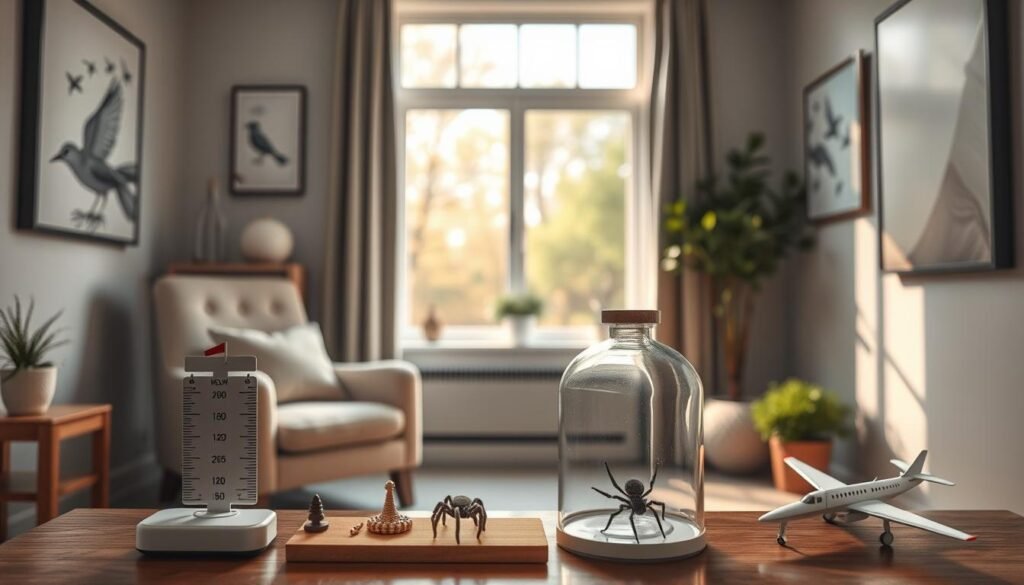About 20% of people in the U.S. face anxiety yearly. This shows a big need for helpful anxiety relief methods. Options like cognitive behavioral therapy, mindfulness, deep breathing, or relaxation techniques can help reduce anxiety symptoms. These methods are key to better mental health and improving life overall.
Those with anxiety may find everyday tasks challenging. The American Psychological Association says many see improvements after 8 to 10 therapy sessions. This highlights how structured interventions work. The right diagnosis and treatment plans, with family support and monitoring, can really help.
This article talks about several strategies, including cognitive behavioral therapy, mindfulness, and art therapy. These play important parts in treating anxiety. Let’s discover how these interventions offer relief.
Key Takeaways
- Almost 20% of Americans experience anxiety disorders annually.
- Cognitive behavioral therapy is the most recognized method for treating anxiety.
- Effective interventions can lead to significant improvements within 8-10 sessions.
- Mindfulness and relaxation techniques play a crucial role in managing anxiety.
- Proper treatment plans should be tailored to individual symptoms and needs.
Understanding Anxiety Disorders
Anxiety disorders affect many people, with nearly 1 in 5 adults in the U.S. feeling its impact yearly. These disorders have different types, each with its own features and symptoms. Knowing about common anxiety types, causes, and symptoms is key to handle them well. It helps people understand their experiences and get the right help.
Common Types of Anxiety Disorders
Anxiety disorders include conditions such as:
- Generalized Anxiety Disorder (GAD): This is when worry is constant and affects daily life.
- Social Anxiety Disorder: It’s a deep fear of social events, leading people to avoid public places.
- Panic Disorder: This disorder causes sudden and repeated panic attacks, bringing intense fear and physical signs.
- Specific Phobias: It’s a severe fear of particular objects or situations, like heights or spiders, which can disrupt normal life.
- Obsessive-Compulsive Disorder (OCD): It involves unwanted thoughts and actions done to ease anxiety.
- Post-Traumatic Stress Disorder (PTSD): This happens after a traumatic event, causing flashbacks and a lot of stress.
Causes and Symptoms
The causes of anxiety are complex. Genetics, environment, and past events all play a part. Anxiety can show up as:
- Constant worrying
- Feeling restless or on edge
- Having trouble focusing
- Experiencing a fast heartbeat or sweating
- Avoiding things that make you anxious
Getting the full picture of anxiety disorders helps people recognize their own situations. Knowing what to look for aids in finding support and ways to cope. If you’re curious about the five main stages of anxiety, understanding these points is crucial.
| Type of Anxiety Disorder | Prevalence in U.S. Adults | Common Symptoms |
|---|---|---|
| Generalized Anxiety Disorder | About 7 million | Constant worrying, feeling tired, being irritable |
| Social Anxiety Disorder | About 15 million | Fearing judgment, avoiding social gatherings |
| Panic Disorder | About 6 million | Experiencing panic attacks, heartbeat racing, feeling dizzy |
| Specific Phobias | Varies (high prevalence) | Strong fear of certain things or situations |
| Obsessive-Compulsive Disorder | About 2.2 million | Having unwanted thoughts, doing compulsive actions |
| Post-Traumatic Stress Disorder | Affects 3.5% of U.S. adults | Having flashbacks, nightmares, extreme stress |
Importance of Anxiety Interventions
Anxiety interventions are key in improving well-being for those with anxiety disorders. They help manage everyday life better. Symptoms like restlessness and trouble focusing are typical. Without help, anxiety can worsen social and mental health issues. This highlights how vital tailored interventions are.
Impact on Daily Life
Anxiety does more than make you uncomfortable. It makes it hard to work, learn, and interact with others. With up to 30% of people experiencing an anxiety disorder in their lifetime, its effects are widespread. It leads to avoiding social settings, lower productivity, and rocky relationships. Knowing this helps us see why effective solutions are crucial.
Need for Effective Solutions
Finding the right way to tackle anxiety is essential. Treatments like cognitive-behavioral therapy (CBT) have proven helpful. They’ve significantly lowered anxiety levels and boosted overall wellness. For example, one study showed people undergoing treatment felt 20.3% less anxious and 23.0% healthier. These results prove that timely help can lead to better anxiety management.
| Type of Intervention | Impact on Anxiety Levels | Improvement in Wellness Scores |
|---|---|---|
| Experimental Group | 20.3% reduction | 23.0% improvement |
| Control Group | 1.4% reduction | 2.4% improvement |
Effective interventions against anxiety do wonders. They help people regain their functional capacity in life. Tackling anxiety impacts daily needs commitment and action. Both people with anxiety and healthcare providers must work together. This ensures everyone gets the support and treatment they need.
Cognitive Behavioral Therapy (CBT)
Cognitive Behavioral Therapy (CBT) is a top method for dealing with anxiety. It looks at how thoughts, feelings, and actions connect. With CBT, people learn to spot and fight off negative thinking. They gain key skills to build better habits and improve their mental health.
Core Principles of CBT
CBT is founded on important principles:
- Identification of Negative Thoughts: Individuals learn to spot and describe false beliefs.
- Behavior Modification: People do specific activities to swap bad thoughts for good ones.
- Exposure Therapy: This method slowly lets people face what scares them, which can lessen their fear.
- Mindfulness Techniques: This promotes watching thoughts without judgment, which helps with relaxation and handling emotions.
Benefits of CBT for Anxiety
CBT offers many advantages for those fighting anxiety. Studies show that:
- Effective Treatment: A lot of people feel way better after just 8 sessions, with or without meds.
- Enhanced Coping Strategies: Folks learn real ways to deal with anxiety every day.
- Improved Self-Awareness: People understand their thoughts and actions better, leading to smarter decisions.
- Long-Lasting Results: The benefits of what’s learned in therapy stick around long after it ends.
CBT’s proven methods make it a strong tool against anxiety. It offers a route to a more balanced, happier life.
Mindfulness Meditation Techniques
Mindfulness meditation helps us focus on now. It lets us see our thoughts and feelings without judging them. Many like it because it helps lower anxiety.
What is Mindfulness?
Mindfulness means being aware of our thoughts and feelings. It involves meditation, yoga, and breathing mindfully. Studies show it helps control emotions better. For example, a program called Mindfulness-Based Stress Reduction (MBSR) helps reduce anxiety. It gives people tools to handle mental health issues.
How Mindfulness Reduces Anxiety
Mindfulness meditation lowers anxiety in many ways. A study in JAMA Internal Medicine found it reduces symptoms of anxiety and depression. Mindfulness-Based Cognitive Therapy (MBCT) prevents depression from returning. It also helps with anxiety. Just 10 minutes of mindfulness can make us more focused and less stressed. It teaches us to handle anxiety better.
| Mindfulness Technique | Mindfulness Benefits | Research Findings |
|---|---|---|
| Mindfulness-Based Stress Reduction (MBSR) | Reduces anxiety symptoms and enhances emotional regulation | Effective for generalized anxiety disorder according to a 1992 study |
| Mindfulness-Based Cognitive Therapy (MBCT) | Helps in reducing relapse rates in depression and anxiety | 50% reduction in relapse rates found in clinical trials |
| Guided Mindfulness Meditation | Improves focus and reduces stress levels | 10 minutes can lead to enhanced task performance in students |
Deep Breathing Exercises for Anxiety Relief
Adding deep breathing exercises to your daily habits can help control anxiety. They help you relax and trigger a peaceful response from your body. There are many deep breathing methods that can help you feel calmer and reduce anxiety.
Step-by-Step Breathing Techniques
There are different ways to do deep breathing. Each one teaches you to breathe in a way that calms you down. Here are some popular methods:
- Diaphragmatic Breathing: Focus on breathing into your belly, not your chest. Doing this three to four times a day, for up to 10 minutes, helps make it a habit.
- Box Breathing: Breathe in for a count of 4, hold for 4, breathe out for 4, and hold for 4 again. This helps you relax and feel calm with regular practice.
- Equal Breathing: Breathe in and out for the same amount of time. This balances your breathing and improves your mental health with regular practice.
- Lion’s Breath: Take a deep breath in, then breathe out hard while sticking out your tongue. This can wake up your mind and body and ease stress.
Physical Effects of Deep Breathing
Deep breathing can make remarkable changes in your body, helping you feel less anxious. The main benefits include:
| Effect | Description |
|---|---|
| Lowered Heart Rate | Deep breathing slows your heart, making you feel more relaxed. |
| Reduced Blood Pressure | Techniques like resonance breathing keep blood pressure in check during stress. |
| Muscle Tension Relief | It helps ease muscle tightness, reducing anxiety-related discomfort. |
| Improved Mood | Focused breathing is linked to better mood and fewer signs of depression. |
Using these techniques daily strengthens your ability to handle stress. Regular deep breathing not only makes you emotionally stronger but also fights anxiety more effectively.
Exposure Therapy in Treating Anxiety
Exposure therapy is key in treating anxiety disorders. It helps people face and reduce fear of specific situations or things. It uses a step-by-step method to gently expose patients to their fears. This helps them become less sensitive over time.
Understanding Exposure Therapy
Exposure therapy is great for various anxiety issues, like phobias and social anxiety. Studies show 60% to 90% of patients significantly improve. The therapy works by making patients get used to their fears gradually. There are different ways to do this, including real-life exposure and visualization exercises.
Methods of Gradual Exposure
There are many ways to gradually expose patients to their fears. Each method is chosen based on what the patient needs and feels comfortable with. Here are a few:
- In Vivo Exposure: Facing fears in real life, reducing avoidance.
- Imaginal Exposure: Imagining fearful scenarios to lessen fear over time.
- Virtual Reality Exposure Therapy: Using tech to simulate fears, like public speaking.
- Interoceptive Exposure: Inducing anxiety-related physical feelings safely, to combat panic disorder.
Therapists may use different pacing like graded exposure or flooding. They pick the best method based on how severe the anxiety is. Using these approaches helps patients get better.

Relaxation Techniques for Managing Anxiety
Using relaxation techniques is key in managing anxiety. They help people handle stress and boost their well-being. There are many methods like muscle relaxation and visualization. These methods lower stress by reducing cortisol levels. It’s important to know the different techniques to find what works best for you.
Types of Relaxation Techniques
There are many ways to relax that suit different people. Some popular methods are:
- Progressive Muscle Relaxation
- Autogenic Relaxation
- Deep Breathing Exercises
- Guided Imagery
- Yoga and Tai Chi
- Music and Art Therapy
- Aromatherapy
- Massage Therapy
- Biofeedback
- Hydrotherapy
Each method helps in its own way. For example, they can ease muscle tension, lower blood pressure, and help with sleep. About 80% of people using guided imagery see less stress.
Integrating Relaxation into Daily Life
Adding relaxation to your daily life helps with anxiety. Making time for these exercises brings long-term benefits. It’s a habit that keeps your mind calm. Combining these methods with good life strategies works best. Exercising, managing time well, and support from friends help too. For more tips on relaxing, check out this detailed guide.
| Relaxation Technique | Benefits | Effectiveness Rate |
|---|---|---|
| Progressive Muscle Relaxation | Improves mental and physical health | 70% |
| Deep Breathing | Reduces blood pressure | 60% |
| Guided Imagery | Decreases stress and improves sleep | 80% |
| Biofeedback | Reduces muscle tension | 75% |
| Autogenic Training | Increases relaxation response | 50% |
Trying different relaxation methods can improve your life and help with anxiety.
Self-Help Strategies for Anxiety Management
Creating an anxiety management toolbox is key. It helps people handle anxiety every day. Everyone’s experience is different, so mixing techniques can work better. Knowing what makes your anxiety spike is the first step to manage it well.
Developing a Personal Toolbox
Anxiety toolboxes should have many tools. They help lessen anxiety signs. You might use:
- Physical Activity: 2½ hours of medium-hard exercise each week helps your mind. Add 1¼ hours of harder activities, like running, for more help.
- Journaling: Writing down your feelings can make you less anxious and clearer minded.
- Mindfulness Techniques: Staying in the now can swap panic for curiosity.
- Aromatherapy: Some folks feel less anxious with certain smells around.
Daily Practices for Reducing Anxiety
Daily habits can help you fight anxiety over time. Using these tips often builds up your ability to manage anxiety:
- Consistency in Exercise: Working out 3 to 5 times a week is good for both mind and body. Even 30 minutes of dancing or biking can make a big difference.
- Healthy Lifestyle Choices: Eating well and sleeping enough set up a strong base for fighting anxiety. A balanced diet helps with mood and energy.
- Social Connections: Hanging out with supportive people is key. It helps you feel connected and strong when stressed.
Managing anxiety is a continuous effort. Trying different self-help steps and making small changes helps understand personal triggers better. For more tips, check out this resource.

| Strategy | Benefits |
|---|---|
| Physical Activity | Reduces stress and improves mood |
| Journaling | Encourages emotional processing |
| Mindfulness Techniques | Promotes present moment awareness |
| Aromatherapy | May help reduce anxiety symptoms |
Role of Therapy Groups in Anxiety Recovery
Therapy groups offer a vital support network for those battling anxiety. They provide a space where you can meet others who understand your struggles. Here, you can share your stories and grow together.
The sense of community in these groups helps a lot. It makes you feel less alone. This can make a big difference in your recovery journey.
Benefits of Peer Support
Joining therapy groups can be very beneficial. These benefits cover a wide range.
- Shared Experiences: You realize you’re not facing your challenges alone.
- Motivation and Commitment: Seeing others making progress can motivate you to stick with your treatment.
- Cost-Effective Options: Group therapy can be cheaper than individual sessions. This makes getting help more affordable.
- Skill Development: You can learn new ways to cope from group discussions.
- Improved Social Skills: These groups also give you a chance to work on your social skills, which is especially helpful for people with social anxiety.
Group therapy gives you important social practice, which is great for facing specific fears. Even with challenges like finding the right schedule or worrying about privacy, these groups offer strong support. They can really enhance your therapy experience.
In short, therapy groups play a crucial role in overcoming anxiety. They let you benefit from being on this journey together with others. The support and understanding you find can be deeply impactful.
| Benefits of Therapy Groups | Description |
|---|---|
| Shared Experiences | You realize you are not alone. |
| Motivation | Seeing others succeed boosts your own resolve. |
| Cost-Effectiveness | More budget-friendly than one-on-one therapy. |
| Skill Development | Learning new coping techniques from group talks. |
| Improved Social Skills | Practicing conversation improves your social abilities. |
Understanding Anti-Anxiety Medications
Anti-anxiety medications offer relief for those struggling with anxiety. They work best when paired with therapy. Knowing about the different types and their effects is key to making the right choice.
Types of Medications Available
There are several medications to help with anxiety symptoms. The most common types are:
- Selective Serotonin Reuptake Inhibitors (SSRIs) – Medications like Citalopram and Sertraline are in this group. They’re usually the first choice for treating long-term anxiety.
- Benzodiazepines – Options like Alprazolam (Xanax) and Diazepam (Valium) provide quick relief for sudden anxiety. These work fast, often within 30 minutes to an hour.
- Buspirone – This is mainly prescribed for general anxiety and is less likely to be habit-forming compared to benzodiazepines.
Pros and Cons of Medication
Anti-anxiety meds can really help, but weighing the good against the bad is important.
| Pros | Cons |
|---|---|
| Can greatly lower anxiety symptoms. | Benzodiazepines may cause dependency. |
| SSRIs and Buspirone usually have fewer side effects. | SSRIs could lead to nausea and sexual issues. |
| Quick relief options are available. | Long-term use of benzodiazepines might not work as well later on. |
| They can better your life by easing anxiety. | Stopping benzodiazepines suddenly may result in harsh withdrawal signs. |

If you’re thinking about anti-anxiety meds, talk to a health professional. You can together decide on a personal plan. This way, managing anxiety becomes more effective and less daunting.
Conclusion
Managing anxiety disorders needs effective interventions to improve mental health. Treatments like cognitive behavioral therapy and mindfulness help. People can pick the best strategy for them.
Cognitive therapy for social anxiety in teens shows promise. Studies in Child and Adolescent Mental Health Services show positives. They highlight early benefits and how it helps school involvement.
We need to support comprehensive treatment plans. These should mix therapies, self-help, and sometimes meds. This way, individuals can overcome anxiety and enjoy life more.